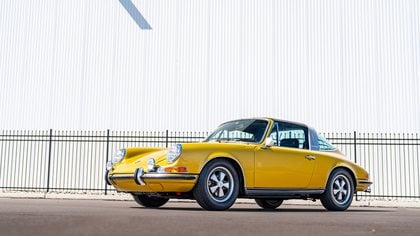Description
It is one of the most iconic sports cars from the Stuttgart-based automotive manufacturer, with a history that began in the late ?50s when the automaker sought to replace its first production car, the 356. In 1963, the 911 made its debut with an innovative design, retaining the rear engine but featuring a longer, wider monocoque and a modern design characterized by a silhouette that remains iconic and unmistakable to this day.
Over the years, Porsche has produced several generations, each bringing technological and stylistic improvements. However, the short-wheelbase first series remains a timeless icon.
The Targa was the first ?open-top? version of the model, named in honor of the legendary Sicilian race, the Targa Florio. Presented at the Frankfurt Motor Show in September 1965, the Targa went into production in January 1967 exclusively in the ?soft-window? version, with a plastic rear window that could be lowered and anchored to the brushed steel roll bar. Cars with the soft-window are quite rare today as it was often replaced by a glass rear window at the time. At the end of the first year of production, a total of 718 units were produced.
The 911S trim (or ?Super?) was the second major innovation introduced in 1967. Available alongside the standard version, the Porsche 911S was equipped with the same 1911cc flat-six engine but enhanced to deliver 160hp at 7200 rpm. The engine underwent significant revisions, including valve diameter and timing adjustments, and the adoption of Weber 40 IDS 3C carburetors with 32mm venturis. The Porsche 911S was available in both Coupe and Targa versions. According to some sources, in 1967, 1823 ?S? models were assembled out of a total of 6445, with only 236 in Targa configuration.
The interiors of the 911S were essentially similar and featured an anti-glare dashboard with a horizontal central insert in geometric-patterned skai synthetic leather instead of aluminum. The instrument cluster remained with 5 elements. The steering wheel rim was covered in leather, while the flooring was ?Velour.? The 911S trim included a 5-speed manual transmission, radial tires, ventilated disc brakes, and a suspension overhaul that incorporated anti-roll bars on both axles and Koni shock absorbers. Standard features included fog lights, Fuchs wheels, and rubber inserts on the front and rear bumperettes.
The third and final major innovation introduced in 1967 was the much-loved Fuchs alloy wheels in 4. 5J size and 15-inch diameter.
The 911 S we offer is in the top-of-the-line configuration, ?Targa S,? from the series called ?Urmodell,? the first series, short wheelbase, produced between 1966 and 1968, in very few units and distinguished by the short wheelbase, a soft rear window, Recaro seats, and Fuchs alloy wheels.
The car has recently undergone a complete restoration by the renowned Bologna-based body shop, Serrattini, concerning the bodywork.
The mechanics have been restored to 0 km by the Swiss Porsche specialist, Ueli Dibach.
The upholstery was done by Enrico Ferraresi, a leading figure in Stuttgart car interiors.
The car is in excellent condition, ready to be used for any occasion.
















